| dc.description.abstract | Research by Swami (2015) indicates that aesthetic stimuli may improve our understanding of individual differences in artistic preferences. However, those findings were exploratory and more comprehensive measures of individual differences in art preferences should be employed. Our study further investigated whether a person’s personality could determine their art preference. Additionally, we explored mood and life orientation (optimism or pessimism) as predictors. The objective of this research project is to investigate the extent to which an individual’s mood and personality predict their art preference. The significance of this research project is that if certain moods and personalities favor a particular genre of art, thus providing a better understanding of artistic styles. It can also display the way people express themselves through aesthetical choices.
Five surveys were administered to 160 participants (males=43, females=122) enrolled in undergraduate classes at a large Southwestern public university: the Costa & McCrae (NEO-PI) Big Five Test, the Profile of Mood States Survey, and two measures of art preference. Both art preferences surveys were administered electronically via URL link prior to the mood and personality surveys, which were garnered within a classroom. SAS procedures were employed to conduct a MANOVA. Thus, the six art genres (Impressionism, Abstract, Cubism, Japanese, Northern Renaissance, Secular Islamic) were compared on the Big Five (NEO-PI), and Profile of Mood States (POMS). A significant Wilks’ λ {F (70,608) = 1.66, p<0.001 was noted. Specifically, there were significant differences between genres on the POMS Tension scale (F5, 140) = 2.44, p< 0.04), Depression scale (F5, 140) = 4.46, p<0.0008), Anger scale (F5, 140) = 3.54, p< .005), Confusion scale (F5, 140) = 3.35, p< 0.007), and Total Mood Disturbance composite score (F5, 140) = 3.50, p< .005). The Masculine-Feminine construct was also found to be highly significant (F5, 140) = 8.62, p< 0.0001) between genres. Finally, the Abstract-Realism construct (F5, 140) = 3.90, p< 0.002) also found specific differences between genres. It is intriguing that mood was so strongly related to art genre preference. This would suggest research to further investigate this relationship. Specifically, observing the relationship between art genres and POMS indices of Tension, Depression, Anger, and Confusion. Depression was the most significant of the POMS measures, suggesting that variances in mood between genres can be most identified through depression. Additionally, the Big Five (NEO-PI) reveals that Openness has a relationship with art genre preference. This dimension was initially hypothesized as a predictor because people low on Openness tend to be conventional, un-artistic, and un-analytical while people high on Openness tend to be curious, creative, and untraditional. These characteristics logically seem relevant in relation to artistic preference. The relationship between mood and art preference might suggest inclusion of artistic material in a therapy regimen. | en |


